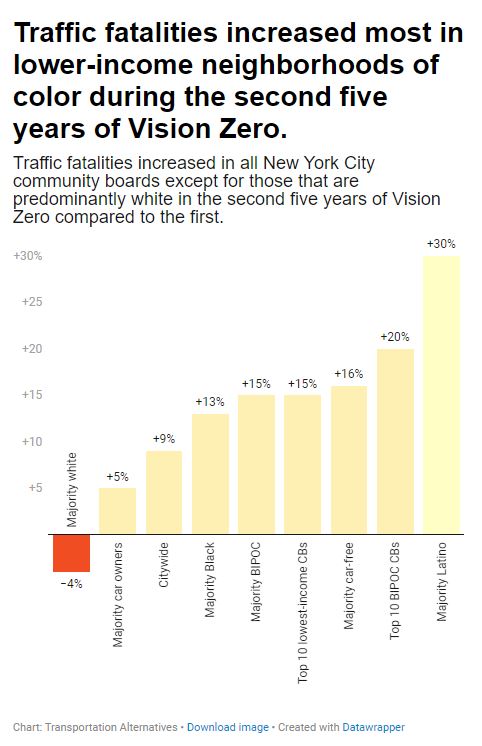Vision Zero: A Decade of Progress Amid Inequality of Treatment on NYC Streets
 As car accident lawyers involved in the fight for safer streets in New York, the recent analysis by Transportation Alternatives and Families for Safe Streets on the first 10 years of Vision Zero provides a critical look at the successes and challenges of this ambitious program. This analysis sheds light on the nuances of traffic safety and underscores the disparities that persist, despite overall improvements.
As car accident lawyers involved in the fight for safer streets in New York, the recent analysis by Transportation Alternatives and Families for Safe Streets on the first 10 years of Vision Zero provides a critical look at the successes and challenges of this ambitious program. This analysis sheds light on the nuances of traffic safety and underscores the disparities that persist, despite overall improvements.
Vision Zero’s implementation over the past decade has undeniably made New York City streets safer. Traffic fatalities were 16% lower in the last ten years compared to the decade preceding Vision Zero, translating to more than 450 lives saved. This achievement is significant and reflects the impact of concerted efforts in street redesign, the installation of speed safety cameras, and the lowering of speed limits across the city. Pedestrian fatalities have seen a remarkable 29% decrease from 2014 to 2023, showcasing the effectiveness of citywide safety initiatives.
However, the analysis also highlights concerning trends, particularly the increase in traffic fatalities in majority-BIPOC and majority-Latino community boards, and the alarming rise in cyclist deaths. These statistics point to a stark reality: while some communities have become safer, others have seen an increase in traffic violence, underscoring the need for a more equitable implementation of Vision Zero strategies.
The increase in fatalities among cyclists, with 2023 marking the deadliest year since 1999, is particularly distressing. This surge in cyclist fatalities, with a 41% increase in the latter half of the Vision Zero era compared to the first five years, signals a critical need for the expansion of protected bike lanes and safer infrastructure to accommodate the growing number of New Yorkers who choose biking as their mode of transportation.
The disparity in traffic fatality trends between majority-white communities and communities of color is a glaring issue.
While fatalities have fallen by 4% in majority-white community boards, they have increased by 15% in majority-BIPOC community boards and by a staggering 30% in majority-Latino community boards. This discrepancy highlights the necessity of prioritizing safety measures and investments in neighborhoods that are currently underserved by Vision Zero initiatives.
The analysis further reveals that nearly 100% of bike riders killed during the first decade of Vision Zero were on streets without protected bicycle infrastructure, and motorist fatalities have continued to rise, especially in communities of color. These findings emphasize the urgent need for comprehensive street redesigns and the expansion of safety measures to protect all road users, regardless of their mode of transportation or where they live.
As we reflect on the first decade of Vision Zero, it’s clear that while significant progress has been made, much work remains to be done to achieve the goal of eliminating traffic deaths in New York City. The data presented by Transportation Alternatives and Families for Safe Streets serves as a crucial call to action for city leaders, policymakers, and advocates to redouble their efforts, allocate the necessary resources, and implement Vision Zero strategies with the urgency and equity they require.
To truly achieve Vision Zero, we must commit to designing streets that prioritize the safety of all New Yorkers—pedestrians, cyclists, and motorists alike. This includes expanding protected bike lanes, redesigning dangerous streets, and ensuring that safety measures are implemented equitably across all communities. Only then can we hope to realize a New York City where everyone can move freely and safely, without the fear of traffic violence.
 New York Personal Injury Attorneys Blog
New York Personal Injury Attorneys Blog


